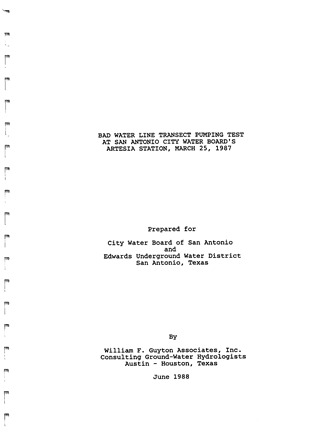Bad Water Line Transect Pumping Test at San Antonio City Water Board’s Artesia Station, March 25, 1987

| Author | William F Guyton Associates, Inc |
| Year | 1988 |
| Description | Pumping test at the San Antonio Artesia Station to determine stability and recovery of wells from stress. Note: Page-size and large-format plates are at the end of the document. |
| Publisher | William F Guyton Associates, Inc |
| Location | Edwards Aquifer, Balcones Fault Zone, San Antonio Segment, San Antonio, Artesian Zone |
| Cover | View Download |
| File | View Download |
| Summary |
|
This report discusses the pumping test that was made of wells located at the City Water Board’s Artesia Station to stress the Edwards aquifer. Artesia Station is located at the north end of a line of monitor wells that comprise the Edwards Aquifer Bad Water Line Transect in San Antonio. The pumping test was planned jointly by the City Water Board, U. S. Geological Survey, and William F. Guyton Associates, Inc. It consisted of a 12-hour non-pumping period during which water levels at the various wells were measured to identify water-level trends, a 12-hour period of continuous pumping at a constant rate from three of the production wells at Artesia Station, and a 6-hour non-pumping period during which water-level recovery measurements were made at the non-pumping wells. In addition, two sets of water samples were collected from each of the pumped wells during the test for chemical analysis by the U.S. Geological Survey. Data from the test were analyzed to determine hydraulic conditions in the aquifer in the vicinity of the Bad Water Line Transect and the impact of this large-scale nearby pumping. … The results from the test show an apparent transmissivity for the Edwards aquifer that is large and in the range from about 6,000,000 to 8,000,000 gallons per day per foot. Because of the way in which hydraulic boundaries affect the results from pumping-test analysis, the actual transmissivity of the Edwards between boundaries is believed to be considerably larger than this. Drawdowns of water level occurred in both the fresh and saline zones of the aquifer as a result of pumping at a rate of 36 million gallons per day for 12 hours, and ranged from less than 2-1/2 feet at the non-pumped wells at and near Artesia Station to about 1.4 feet at Well J-17 located about 3-1/4 miles north of the station. Chemical analyses show there was no significant change in the quality of the water produced by the pumped wells during the 12-hour pumping period. |
Search for Documents
Advance Search
Explore EAA's Scientific Reports
- All Reports
- Water Use and Conservation
- Geochemistry
- Water Resources Planning and Management
- Floods and Drought
- Water Quality
- Climatology
- Surface Water / Groundwater Relationship
- Biology
- Springs, Groundwater Discharge
- Archaeology
- RZ Protection
- Aquifer Levels
- Remote Sensing
- Precipitation
- Overview Studies
- Modeling
- Hydrology and Hydrogeology
- History
- Groundwater Recharge, Recharge Zone
- Groundwater Movement
- Geomorphology and Caves
- Weather Modification
- Geology
